Intermarkets' Privacy Policy
Donate to Ace of Spades HQ!
aceofspadeshq at gee mail.com
Buck:
buck.throckmorton at protonmail.com
CBD:
cbd at cutjibnewsletter.com
joe mannix:
mannix2024 at proton.me
MisHum:
petmorons at gee mail.com
J.J. Sefton:
sefton at cutjibnewsletter.com
Mid-Morning Art Thread
The Morning Report — 12/25/25
Christmas Day Tech News 2025
Christmas Eve Open Thread - December 24, 2025 [Nativity Adjacent Rex]
Christmas Eve Cafe
The Christmas Week In Woke
Charlottesville, VA Disables Citywide Crime Cameras to Help Illegal Alien Criminals Evade the Law
The Games We Used to Play Open Thread
Over 100 Minnesota Mayors Declare That Tim Walz Has Bankrupted the State With Unchecked Fraud and Rampant Spending;
Tim Walz Blames "White Supremacy"
Jim Sunk New Dawn 2025
Jewells45 2025
Bandersnatch 2024
GnuBreed 2024
Captain Hate 2023
moon_over_vermont 2023
westminsterdogshow 2023
Ann Wilson(Empire1) 2022
Dave In Texas 2022
Jesse in D.C. 2022
OregonMuse 2022
redc1c4 2021
Tami 2021
Chavez the Hugo 2020
Ibguy 2020
Rickl 2019
Joffen 2014
maildrop62 at proton dot me
TBD
CAC's Spaced-Out Challenge: the Leo Triplet and Seashell Galaxy
This week, we jump back out into the extragalactic universe with two challenges, one for dark sky observers, and one for city-dwellers.
This also marks the last night in the annual Globe at Night survey. If the weather permits, take a few minutes to check out (or try to) Leo, and submit your observation. You may be surprised, after a few minutes of darkness adaptation, how many stars you can actually spot. Sky maps and images below.
With the moon close to new, we can enjoy the hunt for galaxies for a few more weeks before the Summer Milky Way takes center stage.
For Urban Astronomers:
The Leo Triplet (or at least two thirds)

About the object:
This small galaxy group is about 35 million light years distant and features two spiral galaxies, one face-on (M65), one more angled (M66), along with an unbarred spiral seen near-edge-on with a prominent dust lane (NGC 3628 ).
Messier 65 and 66 (FULP 115,116) jumped into my eyepiece a month back, to my total shock. With few guide stars in my bright skies, I had to do a triple-take to make sure I wasn't just hallucinating the two smudgy but obvious clumps of gas and stars before me. I even think I spotted the fainter member of this group, NGC 3628, but I'll need to recheck. So here's your challenge: do me one better. Find them all. Here's how.
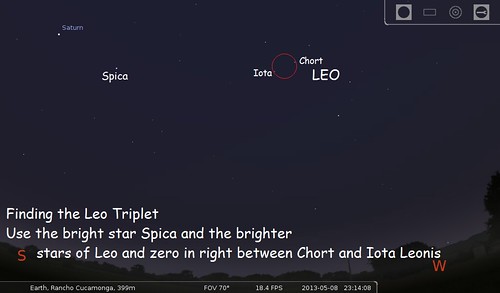
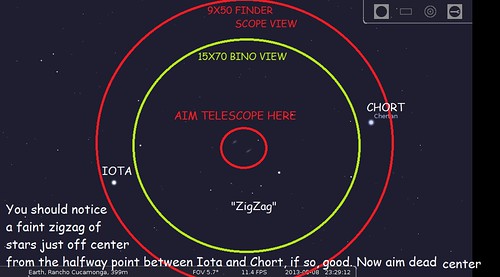
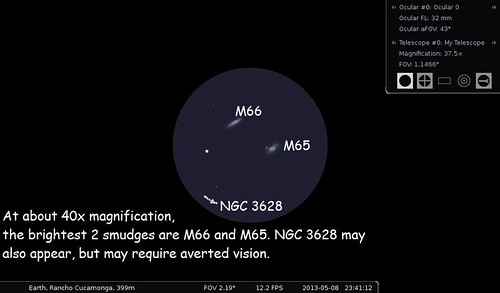
For dark sky observers:
The Seashell (Southern Pinwheel) Galaxy, M83

About the object:
One of the closest and brightest barred spiral galaxies to us, M83 anchors a "group" that includes Centaurus A discussed on an earlier astronomy thread, though the grouping is now in question as the proper motion of these galaxies isn't what it first seemed. It's brightness places it well within binocular range in dark sky sites. Here's how to find it.
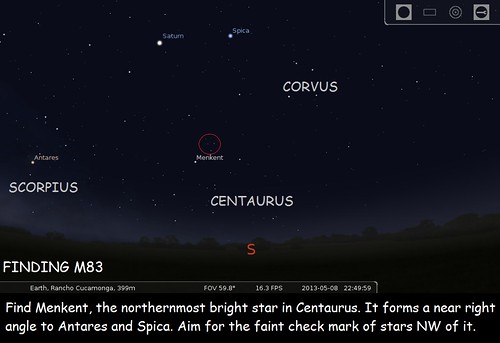
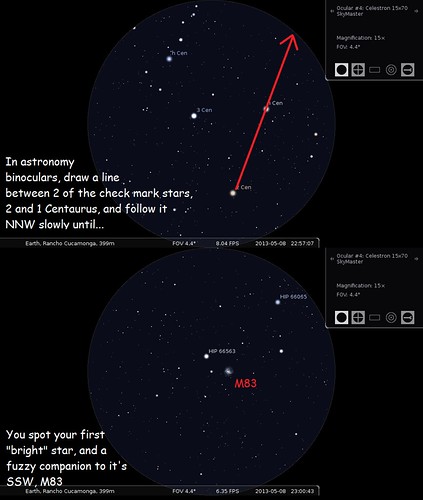
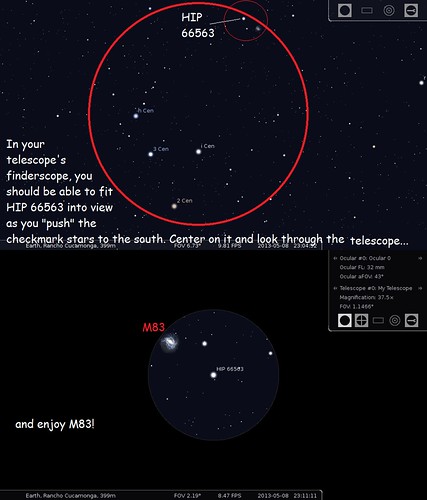
Now, if you have clear enough skies in the city to spot the brightest members of the Leo Triplet, you can take M83 on as well. Refer to stellarium or a similar program to reconfigure the above initial sky map to reflect your light-polluted view, and go from there. Much of the detail in the arms will be totally washed out barring you have an enormous instrument, but it's still worth a try and has been spotted by amateurs from less-than-ideal settings.
Expanded FULP List
First mentioned here a few weeks back, I received a few emails from morons who made additional suggestions to the list. In addition to their suggestions, I scanned the interwebs and old issues of S&T for other surprise urban targets. Needless to say, the list grew a lot longer, with dozens of double stars, galaxies, and clusters added in.
As the year unfolds, I'll update certain entries on it to include finder charts and tips from individual astronomy threads. For now, enjoy the single most comprehensive list of objects that can be spotted from severely light polluted skies, given filters, decent eyepieces, a modest telescope (for many of these, just binoculars), and patience here. You may be surprised just how deep you can go from Queens: Quasar 3C 253, 2.5 billion light years distant, is well within your reach.
For those really bent on nailing all the items on the list, here are a few items you may find useful along the way, courtesy Ace's amazon store:
Celestron's O-III filter (for planetary and some emission nebula) HERE
Orion's Ultrablock filter (for other nebula and some detail in galaxies) HERE
Company Seven's excellent observer's chair HERE
Orion's excellent economy barlow lens, the Shorty, HERE
Orion's budget wide-field eyepiece, the Q70 (32mm) HERE
and for those of you with the big bucks, a host of Televue eyepieces and barlows HERE
For those looking for a first-time scope, particularly city dwellers, you can't go wrong with the 8" Orion XT8 dobsonian, which I've been using for over 2 years now. It has the highest rating for any scope on Amazon and if you buy it during the right months, it ships for free. 8" HERE
Until next time, clear skies and keep looking up!
mrp: "Interesting choice of clothing and chapeau for Mar ..."
Anna Puma: "[i]Cliff Clavin trivia tells me that’s where ..."
Itinerant Alley Butcher: "The darkening of old paintings over time is genera ..."
Captain Obvious, Laird o' the Sea: "SPONGE!!!!!! ..."
All Hail Eris, She-Wolf of the 'Ettes 'Ettes: ""if you don't like it, I can swap it out for a Luf ..."
Opinion fact: "> Friend gifted me a kit with the offer, "if you d ..."
Sponge - F*ck Cancer: "Merry Christmas!!!!! ..."
Sponge - F*ck Cancer: "FIRST!!!!! ..."
Opinion fact: "Posted by: Wolfus Aurelius, Dreaming of Elsewhere ..."
I'm a GOAT, dammit: "Lounging cat? LOUNGING CAT???!!!! ..."
fluffy: ">>> Friend gifted me a kit with the offer, "if you ..."
Mid-Morning Art Thread
The Morning Report — 12/25/25
Christmas Day Tech News 2025
Christmas Eve Open Thread - December 24, 2025 [Nativity Adjacent Rex]
Christmas Eve Cafe
The Christmas Week In Woke
Charlottesville, VA Disables Citywide Crime Cameras to Help Illegal Alien Criminals Evade the Law
The Games We Used to Play Open Thread
Over 100 Minnesota Mayors Declare That Tim Walz Has Bankrupted the State With Unchecked Fraud and Rampant Spending;
Tim Walz Blames "White Supremacy"
Paul Anka Haiku Contest Announcement
Integrity SAT's: Entrance Exam for Paul Anka's Band
AllahPundit's Paul Anka 45's Collection
AnkaPundit: Paul Anka Takes Over the Site for a Weekend (Continues through to Monday's postings)
George Bush Slices Don Rumsfeld Like an F*ckin' Hammer
Democratic Forays into Erotica
New Shows On Gore's DNC/MTV Network
Nicknames for Potatoes, By People Who Really Hate Potatoes
Star Wars Euphemisms for Self-Abuse
Signs You're at an Iraqi "Wedding Party"
Signs Your Clown Has Gone Bad
Signs That You, Geroge Michael, Should Probably Just Give It Up
Signs of Hip-Hop Influence on John Kerry
NYT Headlines Spinning Bush's Jobs Boom
Things People Are More Likely to Say Than "Did You Hear What Al Franken Said Yesterday?"
Signs that Paul Krugman Has Lost His Frickin' Mind
All-Time Best NBA Players, According to Senator Robert Byrd
Other Bad Things About the Jews, According to the Koran
Signs That David Letterman Just Doesn't Care Anymore
Examples of Bob Kerrey's Insufferable Racial Jackassery
Signs Andy Rooney Is Going Senile
Other Judgments Dick Clarke Made About Condi Rice Based on Her Appearance
Collective Names for Groups of People
John Kerry's Other Vietnam Super-Pets
Cool Things About the XM8 Assault Rifle
Media-Approved Facts About the Democrat Spy
Changes to Make Christianity More "Inclusive"
Secret John Kerry Senatorial Accomplishments
John Edwards Campaign Excuses
John Kerry Pick-Up Lines
Changes Liberal Senator George Michell Will Make at Disney
Torments in Dog-Hell
The Ace of Spades HQ Sex-for-Money Skankathon
A D&D Guide to the Democratic Candidates
Margaret Cho: Just Not Funny
More Margaret Cho Abuse
Margaret Cho: Still Not Funny
Iraqi Prisoner Claims He Was Raped... By Woman
Wonkette Announces "Morning Zoo" Format
John Kerry's "Plan" Causes Surrender of Moqtada al-Sadr's Militia
World Muslim Leaders Apologize for Nick Berg's Beheading
Michael Moore Goes on Lunchtime Manhattan Death-Spree
Milestone: Oliver Willis Posts 400th "Fake News Article" Referencing Britney Spears
Liberal Economists Rue a "New Decade of Greed"
Artificial Insouciance: Maureen Dowd's Word Processor Revolts Against Her Numbing Imbecility
Intelligence Officials Eye Blogs for Tips
They Done Found Us Out, Cletus: Intrepid Internet Detective Figures Out Our Master Plan
Shock: Josh Marshall Almost Mentions Sarin Discovery in Iraq
Leather-Clad Biker Freaks Terrorize Australian Town
When Clinton Was President, Torture Was Cool
What Wonkette Means When She Explains What Tina Brown Means
Wonkette's Stand-Up Act
Wankette HQ Gay-Rumors Du Jour
Here's What's Bugging Me: Goose and Slider
My Own Micah Wright Style Confession of Dishonesty
Outraged "Conservatives" React to the FMA
An On-Line Impression of Dennis Miller Having Sex with a Kodiak Bear
The Story the Rightwing Media Refuses to Report!
Our Lunch with David "Glengarry Glen Ross" Mamet
The House of Love: Paul Krugman
A Michael Moore Mystery (TM)
The Dowd-O-Matic!
Liberal Consistency and Other Myths
Kepler's Laws of Liberal Media Bias
John Kerry-- The Splunge! Candidate
"Divisive" Politics & "Attacks on Patriotism" (very long)
The Donkey ("The Raven" parody)

